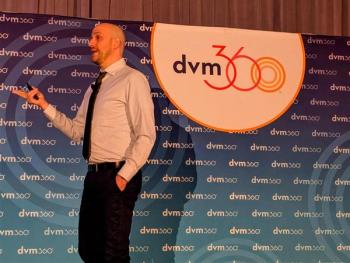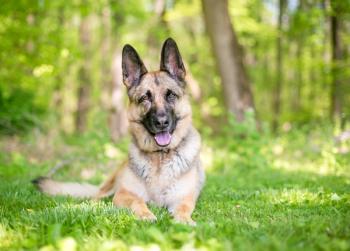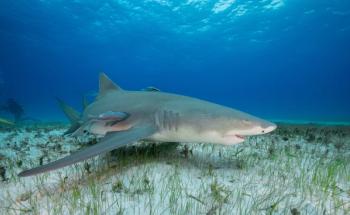
Ultrasonography of the thorax: there's more than just the heart! (Proceedings)
Thoracic radiographs should be performed prior to thoracic ultrasound. Air is a barrier to ultrasound imaging; therefore, assessment must be made on radiographs to determine if a lesion will be visible.
General considerations
Thoracic radiographs should be performed prior to thoracic ultrasound. Air is a barrier to ultrasound imaging; therefore, assessment must be made on radiographs to determine if a lesion will be visible. Pleural fluid can enhance ultrasound imaging; therefore, thoracocentesis is not performed until after the ultrasound exam unless the volume of fluid is compromising the patient. A transducer with a small footprint is recommended for intercostal imaging. Generally a 7.5-10 MHz transducer is adequate. Patient's can be scanned in lateral or sternal recumbency or even standing. A cardiac table is sometimes useful to visualize the non-dependent structures.
Ultrasound of the lung
The normal lung is an echogenic linear band with multiple reverberation artifacts (dirty shadowing). Due to this air interface the internal parenchyma cannot be assessed in the normal animal.
Abnormalities of the lung detected with ultrasound include masses, nodules, atelectasis, and consolidation (as with pneumonia, hemorrhage, or diffuse infiltrative neoplasia). Solitary mass lesions are most commonly pulmonary/bronchogenic carcinoma. These are often solid, hypoechoic masses but can be variable in echogenicity. These lesions can be distinguished from pleural or thoracic wall lesions as they will form an acute angle with the pleural surface and glide with respiratory motion. Peripheral metastatic lesions are round, hypoechoic, and move with the lung. Atelectasis and consolidation appear similar on ultrasound. With these conditions the lung remains normal in shape, but is hypoechoic with a variable amount of linear, hyperechoic gas stripes (air bronchograms). The term "hepatization" of the lung is sometimes used as the lung becomes similar in appearance to the liver.
Ultrasound of the mediastinum
The normal mediastinum is difficult to image because it is surrounded by lung, which results in reflection of the ultrasound beam. Mediastinal masses that are large enough to contact the thoracic wall are easily imaged through the intercostal space. The cranial mediastinum can also be imaged through the thoracic inlet or using the heart as a window. A subcostal window may be used to see abnormalities of the caudal mediastinum. Fat in the mediastinum has an echogenic but homogenous echo texture. Mediastinal vessels are anechoic tubular (longitudinal) to circular (transverse) structures.
Mass lesions are the primary mediastinal disease evaluated with ultrasound, although fluid and fat accumulation are also seen. Lymphoma is the most common mass lesion and typically consists of one or multiple hypoechoic structures in the cranial mediastinum. Less commonly lesions may include thymoma and other types of neoplasia, abscess, granuloma, or cysts. Ultrasound is useful for cyst determination as it can characterize solid versus fluid filled lesions. Assessment of the relationship of the mass with the cranial mediastinal vessels is imperative in cases that may include surgery as a treatment option.
Sternal lymph node enlargement can be detected by use of a window just off midline, dorsal to the 2nd and 3rd sternebra or using the thoracic inlet approach. Normal sternal lymph nodes are difficult to detect, while enlarged nodes are round to oval masses most commonly hypoechoic (but can be variable in echogenicity). The perihilar lymph nodes even when enlarged are usually not visible due to surrounding lung.
Ultrasound of the pleural space
Normally there is not fluid identified in the pleural space with ultrasound. The lung should extend to the margin of the thoracic wall and appear as a highly echogenic line with reverberation artifact. The pleura are generally not recognized but it is important to assess the gliding motion of the lung against the thoracic wall.
Fluid is readily visualized in the pleural space and can be detected earlier with ultrasound than with radiographs. Fluid often makes evaluation of the mediastinum easier. The echogenicity of the fluid is predominantly influenced by the cellular concentration. Transudates, modified transudates, and chylous effusions tend to be anechoic to hypoechoic while exudates, neoplastic effusions, and hemorrhage are generally more echogenic. The type of fluid cannot be diagnosed with ultrasound and thoracocentesis is still required for a definitive diagnosis. If pleural effusion is secondary to another disease the cause of the fluid can often be determined (i.e. heart failure, neoplasia, lung lobe torsion, diaphragmatic hernia, mediastinal mass, etc.) Changing the position of the patient is useful to determine if fluid is mobile within the thorax or trapped within pockets. Echogenic bands of tissue (fibrinous) often form within the fluid in cases of chronic pleural effusions. Roughening of the pleural surfaces or nodules may indicate pleuritis, carcinomatosis, and chronic effusions.
Pneumothorax is generally diagnosed with radiographs rather than ultrasound. On ultrasound pneumothorax will look similar to normal lung (linear hyperechoic band with reverberation artifact); however, the key is to look for the sliding motion of the lung. In cases of pneumothorax this sliding motion will be absent.
Ultrasound of the thoracic wall
In the normal animal the subcutaneous fat and connective tissue are echogenic, while the intercostal muscles are hypoechoic. This results in a layered appearance of the tissues of the thoracic wall. The ribs are curvilinear, echogenic structures with distal acoustic shadowing.
Ultrasound is useful in determining the internal appearance, size, and extent of thoracic wall lesions. Ultrasound can be used for mass lesions (neoplasia, abscess, granuloma) but is particularly useful when looking for foreign bodies of the thoracic wall (as seen with chronic draining tracts). Mass lesions associated with the bone are most often neoplastic. These result in disruption and irregularity of the bone margin. These masses are variable in echogenicity. With inflammation ultrasound is helpful in finding fluid pockets (these may range from anechoic to very echogenic), gas, following draining tracts, and finding foreign bodies. It can sometimes be difficult to diagnose a solid mass versus a highly echogenic fluid pocket. Manually compressing the lesion with the probe can be useful for distinguishing between the two conditions. Foreign material is generally hyperechoic with distal acoustic shadowing. The material is usually surrounded by abnormal soft tissue, which helps in localization.
Interventional techniques
Ultrasound guided thoracocentesis is extremely useful, especially in cases of small volume or localized effusions. A 22-gauge, 1 to 1 ½ inch needle is generally used. In cases of very echogenic, thick fluid 18 to 20-gauge needles may be necessary. Ultrasound guided fine needle aspiration or biopsy of masses is often rewarding. For the aspirates a 22-gauge, 1 to 1 ½ inch needle is used. Biopsy needles used commonly are 14 to 18-gauge with variable throw length. For cranial mediastinal masses it is important to recognize the location of the cranial mediastinal vessels prior to aspiration. Lung aspirates may require temporary respiratory pause. Aspirates are performed with or without sedation dependent on patient compliance, while biopsy is performed under general anesthesia. It is important to evaluate for pneumothorax and hemorrhage following the procedures.
Newsletter
From exam room tips to practice management insights, get trusted veterinary news delivered straight to your inbox—subscribe to dvm360.





